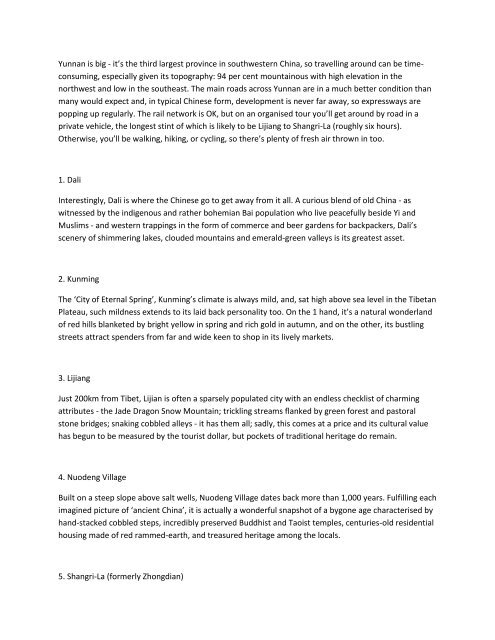You also want an ePaper? Increase the reach of your titles
YUMPU automatically turns print PDFs into web optimized ePapers that Google loves.
Yunnan is big - it’s the third largest province in southwestern China, so <strong>travel</strong>ling around can be timeconsuming,<br />
especially given its topography: 94 per cent mountainous with high elevation in the<br />
northwest and low in the southeast. The main roads across Yunnan are in a much better condition than<br />
many would expect and, in typical Chinese form, development is never far away, so expressways are<br />
popping up regularly. The rail network is OK, but on an organised tour you’ll get around by road in a<br />
private vehicle, the longest stint of which is likely to be Lijiang to Shangri-La (roughly six hours).<br />
Otherwise, you’ll be walking, hiking, or cycling, so there’s plenty of fresh air thrown in too.<br />
1. Dali<br />
Interestingly, Dali is where the Chinese go to get away from it all. A curious blend of old China - as<br />
witnessed by the indigenous and rather bohemian Bai population who live peacefully beside Yi and<br />
Muslims - and western trappings in the form of commerce and beer gardens for backpackers, Dali’s<br />
scenery of shimmering lakes, clouded mountains and emerald-green valleys is its greatest asset.<br />
2. Kunming<br />
The ‘City of Eternal Spring’, Kunming’s climate is always mild, and, sat high above sea level in the Tibetan<br />
Plateau, such mildness extends to its laid back personality too. On the 1 hand, it’s a natural wonderland<br />
of red hills blanketed by bright yellow in spring and rich gold in autumn, and on the other, its bustling<br />
streets attract spenders from far and wide keen to shop in its lively markets.<br />
3. Lijiang<br />
Just 200km from Tibet, Lijian is often a sparsely populated city with an endless checklist of charming<br />
attributes - the Jade Dragon Snow Mountain; trickling streams flanked by green forest and pastoral<br />
stone bridges; snaking cobbled alleys - it has them all; sadly, this comes at a price and its cultural value<br />
has begun to be measured by the tourist dollar, but pockets of traditional heritage do remain.<br />
4. Nuodeng Village<br />
Built on a steep slope above salt wells, Nuodeng Village dates back more than 1,000 years. Fulfilling each<br />
imagined picture of ‘ancient China’, it is actually a wonderful snapshot of a bygone age characterised by<br />
hand-stacked cobbled steps, incredibly preserved Buddhist and Taoist temples, centuries-old residential<br />
housing made of red rammed-earth, and treasured heritage among the locals.<br />
5. Shangri-La (formerly Zhongdian)

















